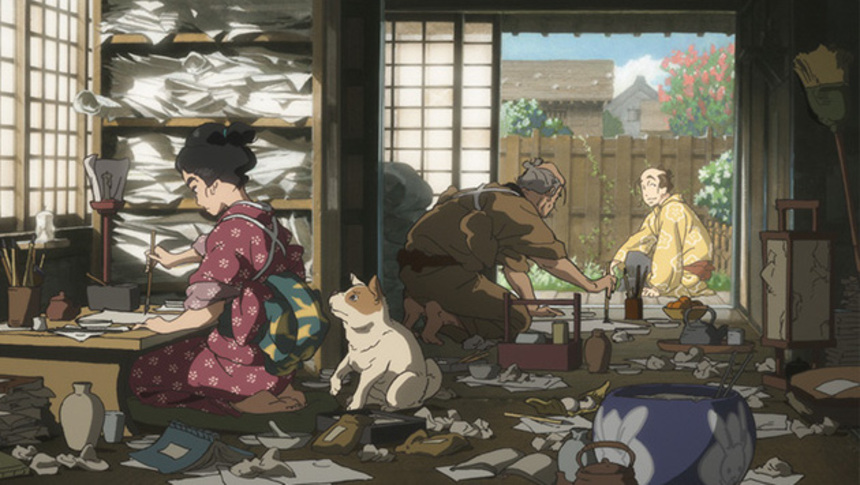Fantasia 2015 Review: MISS HOKUSAI, Full Of Life And Spirit

Blending the magical realism sensibility of Studio Ghibli with Ozu Yasujirô-like framing, and unfortunately an occasionally distracting rock 'n roll score, it is a film that you get so deeply lost in that it is difficult to discern beginning, middle or end. While there is a story of sorts, it is in the vein of something similar to My Neighbour Totoro or Only Yesterday, insofar as any notion of a three-act-plot is rendered meaningless in the face of life and the living of it.
Famed artist Tetsuzo, a.k.a. Hokusai Katsushika, and his (eponymous) grown daughter O-Ei, live in poverty, neither cooking nor cleaning, but living and creating with Tetsuzo's would-be students and hangers on. She often finishes the detailing on her work while simultaneously venting her rage on a drunken ex-Samurai, Zenjirô, who hangs around with a bottle and a brush. One day on a vibrant and bustling bridge she has a kind of meet-cute (involving of all things, dog poop) with a talented artist on the rise, Kuninao Utagawa, who eventually also becomes one of Hokusai's pupils.
This den of ink and crumpled balled-up paper, left-over street food, and the kindest dog outside of an Oshii Mamoru film became a place to discuss art, and technique, and the ineffable qualities that distinguish mere drawings from great and lasting art. O-Ei is discovering her voice in this setting, although she is often left at the wayside as the three men, master and pupils, go off to the Geisha houses and other street shenanigans.
Instead O-Ei spends time with her mother and younger sister, the latter of whom is blind. It is these outings where the film eschews the verbal -- which is strange to say, considering O-Ei spends much time describing the drawings to her sibling -- in favour of embracing the feel of nature and sights and smells of nascent Tokyo; which is what Edo would become after the end of the Tokugawa shogunate.
Clumps of snow on a child's clothing after a tree sheds its frozen powdery bounty; the drip drip drip of raindrops from an umbrella into the fabric of a robe during a rainy walk; a smudge of ink on the face of a beautiful, strong woman; the sound of fire-bells and luminous drift of deadly fireflies as a brigade furiously fights a blaze on a crowded street. These are many of the images that reconciles nature and human endeavour, both furiously beautiful, if only for their fragility. The urge to dangle my feet off a bridge, into cool moving water, with my own children at my side, in comfortable silence, with a hint of far-off birdsong, was palpable during these evocations. The animation has that kind of power.
When father and daughter are creating, or eating, or merely just sitting in their tiny cluttered space, you might, perhaps, begin to understand that immortality or any lasting legacy pales in comparison to the wonder of these perfect, transient moments.
Tetsuzo would go on to create some of the most iconic wood-cut prints that would inspire Western and Eastern artists alike for decades, now centuries, but none of that is featured here. This is about living life as the basis for future creative endeavours, to see the spirit in the loves, regrets, fears, erotic pleasures, regret, and ultimately loss.
While Hokusai's tiny but vibrant commune indulges in low-brow drink-ups and whore house sojourns - a character even proclaims that 'you have got to be dumb to have fun' - Miss Hokusai is nothing if not a rounded work of beauty and intellect. Yokai spirits, Buddha and dragons hiding in wind-storms heighten the periphery of how an artist might see the world. The spirit of chief animator and character designer Yoshimi Itazu (The Wind Rises) are integrated with the backgrounds of Ono Hiroshi (A Letter to Momo, Wolf Children) with the same collaborative brio as father and daughter who are the subjects of the film.
Miss Hokusai
Director(s)
- Keiichi Hara
Writer(s)
- Hinako Sugiura (comic "Sarusuberi")
- Miho Maruo (screenplay)
- Stephanie Sheh (english adaptation)
Cast
- Erica Lindbeck
- Richard Epcar
- Ezra Weisz
- Robbie Daymond

Do you feel this content is inappropriate or infringes upon your rights? Click here to report it, or see our DMCA policy.






